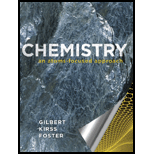
To find:
a) The density of bcc iron, assuming the radius of an iron atom is
b) The density of hexagonal iron, given a unit cell volume
c) The density of
Answer to Problem 18.125QA
Solution:
a) The density of bcc iron is
b) The density of hexagonal iron is
c) The density of silicon substituted iron crystal is
Explanation of Solution
1) Concept:
The unit cell of the iron is given as bcc unit cell. The edge length can be calculated for the given unit cell as the radius of the
2) Formula:
i)
i)
ii)
3) Given:
i) Atomic radii of
ii) Molar mass of
iii) Number of atoms in unit cell
iv) Avogadro’s number
v) Volume of the hexagonal unit of
vi) Molar mass of
4) Calculations:
a) Calculate the density of bcc iron, assuming the radius of an iron atom is
Since the unit cell of
Mass of the unit cell is
Calculate the edge length from atomic radius.
Volume of unit cell
Density of the bcc iron
Hence, the density of the
b) Calculate the density of hexagonal iron, given a unit cell volume
Since the unit cell of
Mass of the unit cell is
Density of the hexagonal iron
Hence, the density of
c) Calculate the density of
It is given that
The mass of
Mass of iron in unit cell is
Density of the system
Hence the density of such a crystal is
Conclusion:
The density of the
Want to see more full solutions like this?
Chapter 18 Solutions
Chemistry: An Atoms-Focused Approach
 ChemistryChemistryISBN:9781305957404Author:Steven S. Zumdahl, Susan A. Zumdahl, Donald J. DeCostePublisher:Cengage Learning
ChemistryChemistryISBN:9781305957404Author:Steven S. Zumdahl, Susan A. Zumdahl, Donald J. DeCostePublisher:Cengage Learning ChemistryChemistryISBN:9781259911156Author:Raymond Chang Dr., Jason Overby ProfessorPublisher:McGraw-Hill Education
ChemistryChemistryISBN:9781259911156Author:Raymond Chang Dr., Jason Overby ProfessorPublisher:McGraw-Hill Education Principles of Instrumental AnalysisChemistryISBN:9781305577213Author:Douglas A. Skoog, F. James Holler, Stanley R. CrouchPublisher:Cengage Learning
Principles of Instrumental AnalysisChemistryISBN:9781305577213Author:Douglas A. Skoog, F. James Holler, Stanley R. CrouchPublisher:Cengage Learning Organic ChemistryChemistryISBN:9780078021558Author:Janice Gorzynski Smith Dr.Publisher:McGraw-Hill Education
Organic ChemistryChemistryISBN:9780078021558Author:Janice Gorzynski Smith Dr.Publisher:McGraw-Hill Education Chemistry: Principles and ReactionsChemistryISBN:9781305079373Author:William L. Masterton, Cecile N. HurleyPublisher:Cengage Learning
Chemistry: Principles and ReactionsChemistryISBN:9781305079373Author:William L. Masterton, Cecile N. HurleyPublisher:Cengage Learning Elementary Principles of Chemical Processes, Bind...ChemistryISBN:9781118431221Author:Richard M. Felder, Ronald W. Rousseau, Lisa G. BullardPublisher:WILEY
Elementary Principles of Chemical Processes, Bind...ChemistryISBN:9781118431221Author:Richard M. Felder, Ronald W. Rousseau, Lisa G. BullardPublisher:WILEY





